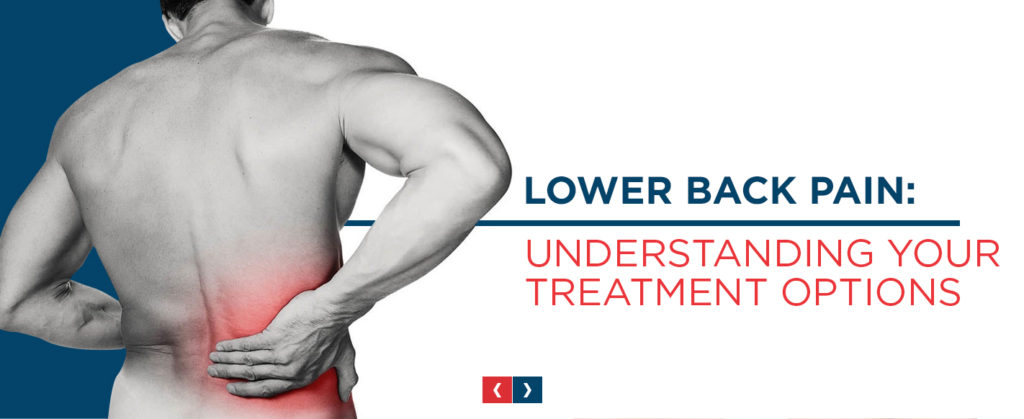
In 2017, 49 percent of adults experienced back pain. Low back pain can be related to a variety of issues, such as muscle strain, age and occupation. No matter the cause, people want to know how to relieve acute or chronic lower back pain. Chronic pain is any pain that lasts for more than three months and affects your quality of life.
The first step to relief for lower back pain is determining the source of your pain. Next, you and your physician will talk about treatment options for lower back pain and how to prevent a recurrence of the same issue.
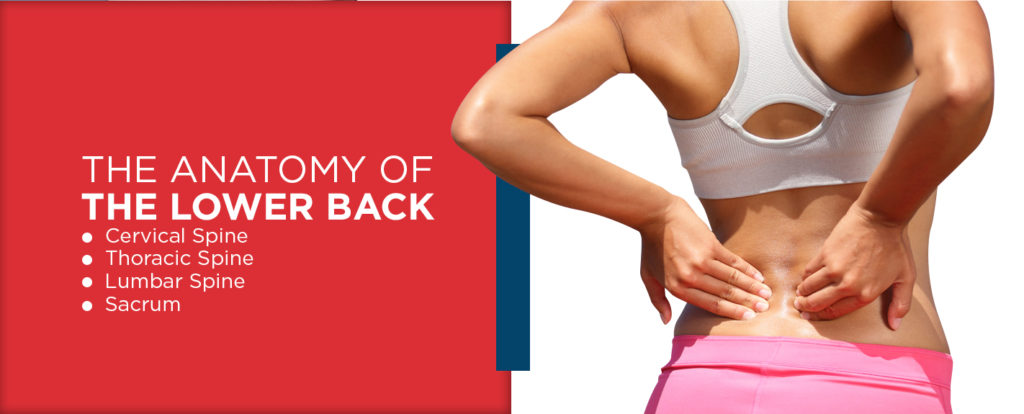
The Anatomy of the Lower Back
In order to understand your lower back pain and the appropriate therapies, you need to understand the anatomy of your back and what could be causing your pain. Armed with this knowledge, you can work with your doctor to reach an accurate diagnosis.
The spine, made up of different bony sections called vertebra, is divided into four different sections:
- Cervical Spine: Refers to your neck
- Thoracic Spine: Refers to your upper and middle back
- Lumbar Spine: Refers to your lower back
- Sacrum: Refers to your tailbone
The vertebrae in your spine are lettered and numbered based on their location — L1 through L5 are the vertebra in your lumbar spine or lower back. Each vertebra is separated by a disc, which provides cushioning for your spine, and each disc has an outer and inner layer. The spine also has 31 pairs of spinal nerves, five of which are located in the lumbar spine.
In addition to your vertebrae, vertebral discs and spinal nerves, your lower back also contains muscles and tendons, which attach muscle to bone. Some of the major muscles in your back include:
- Extensor Muscles: Muscles that help you lift
- Iliocostalis: A muscle important to posture
- Longissimus: A muscle that begins in the lumbar area and extends upward
Any part of your lower back’s anatomy — vertebra, disc, nerve, muscle or tendon — is a possible source of your lower back pain.
Causes of Lower Back Pain
Trauma, overuse and strain are all potential causes of lower back pain. If your vertebrae are the source of your pain, it is possible you have a spinal fracture. People with osteoporosis, a condition that weakens the body’s bones, are at higher risk for spinal fractures.
If a vertebral disc is the source of pain, you may have a herniated disc. This typically happens as a result of age-related degeneration. A herniated disc can cause pain in nearby spinal nerves. This type of pain can be referred to as a “pinched” or compressed nerve.
Muscle and tendon strains can also cause pain in your lower back. This occurs when muscles or tendons in the lower back are stretched or even torn. Lifting heavy objects or general overuse can result in this type of lower back pain.
Other potential causes of lower back pain include scoliosis — a condition that causes the spine to curve sideways — and spinal stenosis, a condition that causes the space around the lumbar spine to narrow and put pressure on spinal nerves.
Diagnosing Lower Back Pain
Obtaining an accurate diagnosis is vital to choosing the best option from the available chronic low back pain treatments. Asking you about your medical history will be the first step your doctor takes when trying to make a diagnosis. Come to your appointment prepared to talk about your symptoms, any injuries you have experienced and your daily activities.
Next, your doctor will likely carry out a physical exam, which involves palpating your lower back to search for any abnormalities. Your doctor will also test your reflexes and range of motion.
If you have a muscle or tendon strain, the physical exam may be enough to reach a diagnosis. Other causes of lower back pain will likely require imaging tests, such as:
- X-Ray: An x-ray will allow your doctor to view the bones of your spine
- CT Scan: A CT scan will provide a more detailed, three-dimensional view of the bones of your spine
- MRI: An MRI can offer insight into soft tissue, like muscles and ligaments
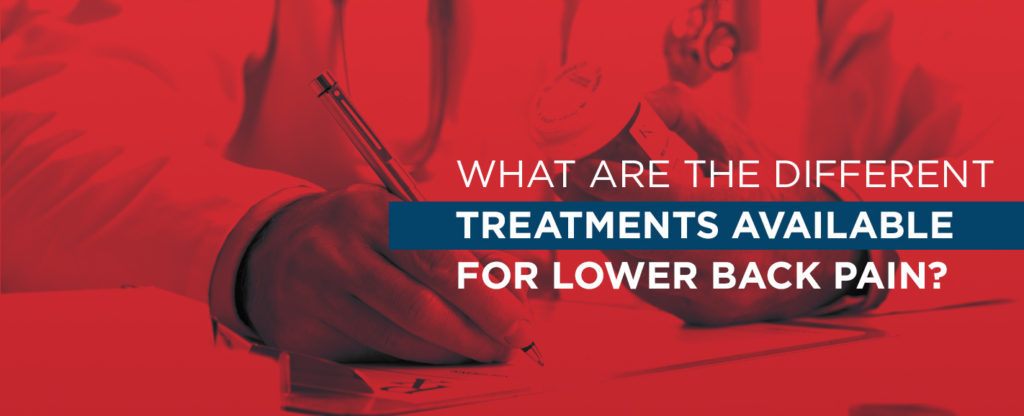
What Are the Different Treatments Available for Lower Back Pain?
What is the right low back pain treatment? The answer to this question will change on a case-by-case basis, as it depends on what caused your lower back pain, what type of pain you are experiencing and what your doctor decides is the best course of action.
Here are five common methods for curing lower back pain.
1. Lifestyle Changes
You can address some causes of lower back pain by making lifestyle changes. For example, committing to a healthier diet and exercise routine can help improve your overall health and relieve lower back pain, as certain foods have inflammatory properties. Smoking can also contribute to lower back pain.
Adjusting your posture is another lifestyle change that can have a significant effect on lower back pain. Many people spend their entire workday at a desk in front of a computer, which can make it easy to fall into the habit of poor posture, either slouching in your chair or hunching forward to look at your computer screen. Notice when you slip into one of these positions, and focus on returning to a good posture. Allow yourself breaks from your desk, too. If available, take advantage of a standing desk.
These lifestyle changes can take time, but once you integrate them into your routine, they can help reduce low back pain and even prevent it in the future.
2. Physical Therapy
Physical therapy is one of the primary lower back pain treatment options. This condition is one of the most common issues physical therapists handle. When you visit a physical therapist, they will evaluate your symptoms and create a custom treatment plan based on those symptoms and your physician’s diagnosis. How often you attend physical therapy will depend on that custom treatment plan.
During your physical therapy sessions, you will go through many different exercises to help strengthen your muscles and address your pain, which may include core strengthening. Your core muscles play a significant role in supporting your back muscles. Weak core muscles can lead to lower back pain.
Your physical therapist could also show you how to do simple exercises at home, either with no equipment or with something simple like an exercise band. Your physical therapist may also employ other techniques like massage therapy to offer you relief from your pain.
3. Medication
Medication is one of the popular remedies for lower back pain. You can buy over-the-counter medications, like ibuprofen, naproxen or acetaminophen to address your symptoms.
Ibuprofen and naproxen are nonsteroidal anti-inflammatory drugs (NSAIDs), while acetaminophen is a pain reliever. These options are best for acute lower back pain that does not persist and become chronic. You can manage simple strains that last for a few days with the help of over-the-counter medication.
If your pain is severe or persistent, you should visit a physician to discuss other treatment options. Your doctor may prescribe you medication, such as stronger NSAIDs, muscle relaxants or opioids. Corticosteroids could also help your condition. This type of medication is typically injected directly into the affected area. If your pain persists despite treatment with medication, your doctor will likely want to explore alternatives.
4. Surgery
If you are wondering how to treat lower back pain that does not respond to any of the treatments you have tried, it is possible you may need surgery.
For example, a person suffering from persistent symptoms related to a herniated disc may be a candidate for a microdiscectomy. This procedure involves making a small incision and removing the disc — or part of the disc — that is causing the problem.
Other common lower back surgeries include a lumbar spinal fusion, placing an artificial disc in the lumbar spine, and a laminectomy. Most physicians will seek to find more conservative treatment options before deciding surgery is the best decision for a patient. Physical therapy will also follow most surgical procedures to help the patient recover fully and prevent further pain.
5. Low-Level Laser Therapy
Low-level laser therapy is one of the newer treatments available for lower back pain. Low-level lasers are different from traditional laser treatments that use “hot lasers,” which tend to be more expensive.
The FX 635 Laser from Erchonia is the only FDA cleared low-level laser for treating lower back pain. During clinical trials, the laser had a 72 percent success rate. Patients included in the trial exhibited a 58 percent reduction in pain after two months.
The low-level laser is a painless, non-invasive treatment that addresses pain through bio-stimulation. When undergoing this treatment, you lay flat on your stomach while the laser does its work.
Many people want to avoid surgery because it’s one of the more invasive and expensive treatment options, and it also requires a recovery period. Medication can have side effects, and some medications, like opioids, can be addictive. Low-level laser therapy with the FX 635 can be an alternative to other treatment options like surgery and medication because it does not have serious side effects.
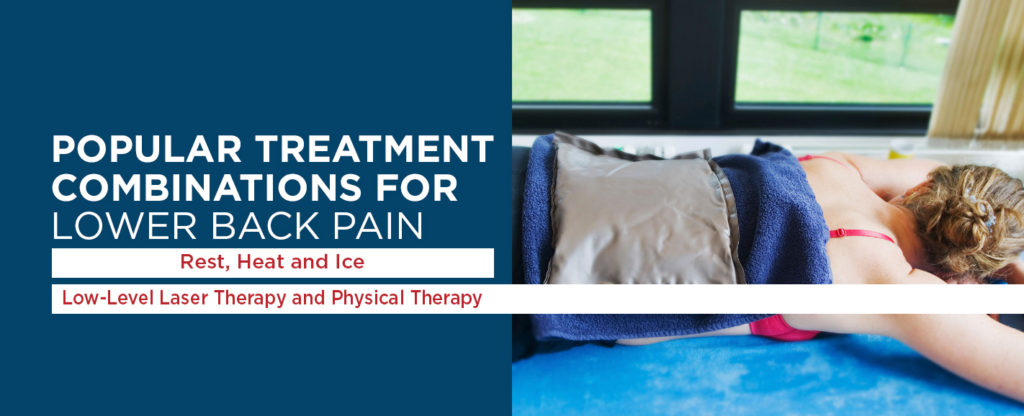
Popular Treatment Combinations for Lower Back Pain
There are many different ways to relieve lower back pain, and sometimes, a single approach is not enough. Do not be afraid to take a versatile approach to treat your back pain.
Here are a few treatment options for chronic back pain that combine different methods:
- Rest, Heat and Ice: This simple combination of treatments is a tried-and-true approach for at-home treatment. Rest allows the muscles in your lower back time to heal if you have experienced a strain. Listen to your body instead of pushing yourself to keep moving when you’re in pain. Allow yourself the time to slow down. However, you do not want to rest for too long. Try lying down for a few hours at a time. While you relax, you can alternately apply heat and ice to the affected area in your lower back. Ice can help reduce inflammation and swelling, while heat can also ease inflammation and help strained muscles relax. Try swapping out heat and ice every 10 to 20 minutes. Apply cold to the affected area using an ice pack. When it comes time to apply heat, you can take a hot shower or bath or use a heating pad. These treatment options can be useful for minor low back pain issues, but if your pain persists, you will need to explore other low back pain treatment options.
- Low-Level Laser Therapy and Physical Therapy: If you are considering what to try for lower back pain, low-level laser therapy can be a great option. The clinical trial results show that the FX 635 Laser has significant potential to reduce your pain and help you return to an active lifestyle in a short period. While this can be a good option for some people, it may be beneficial to pair it with physical therapy. The low-level laser therapy can address your pain, while physical therapy can address the root cause of the pain. Maybe you struggle with good posture. Or, perhaps you are prone to incorrectly lifting heavy objects. Physical therapy can help train your body to strengthen and use your muscles appropriately, which will help prevent pain in the future. Together, low-level laser therapy and physical therapy can help you reduce your pain and get back on the road to feeling good.
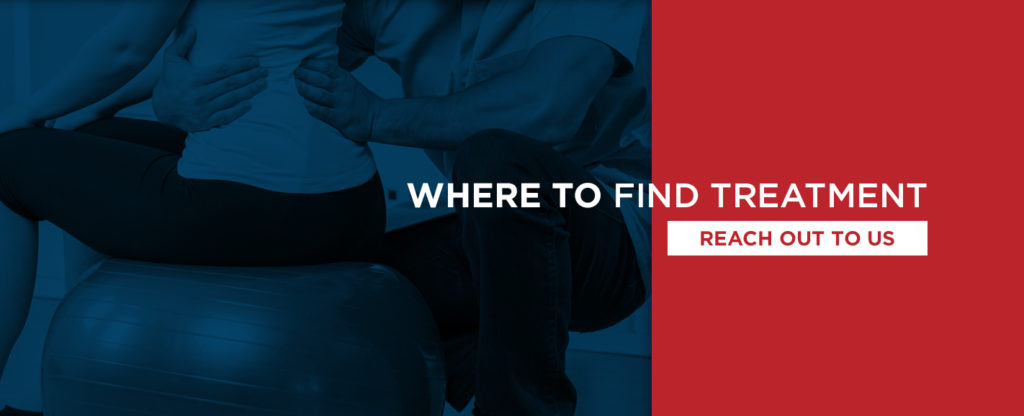
Where to Find Treatment
Many ways to treat low back pain exist, but patients are looking for a way that will get them fast, effective and safe relief. The best therapy choices for low back pain will depend on each person’s symptoms and needs.
Low-level laser therapy is a trusted option for treating pain without opioids. If laser therapy seems like a promising option for you, search for a nearby physician that offers Erchonia Laser treatment. Once you find a provider, you can learn more about the benefits of this therapy option and how many treatments you will need to tackle your chronic pain.
If you are a physician searching for another option to offer your patients suffering from low back pain, reach out to us to learn more about adding an Erchonia laser treatment system to your practice. Many people experience low back pain, and they deserve to have access to options that will help them get back to their pain-free lives.
